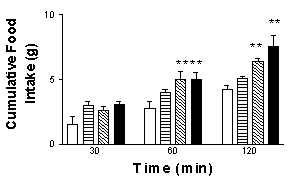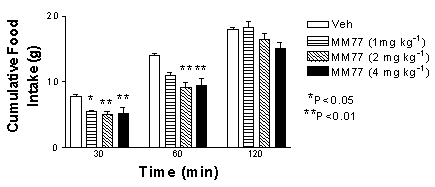| pA2 online © Copyright 2004 The British Pharmacological Society |
017P
University of Buckingham 3th Focused Meeting April 2004 |
|
Effects
of the putative 5HT1A agonist MM-77
on feeding in rats |
|
1-(2-methoxyphenyl)-4-(4-succinimidobutyl)
piperazine (MM-77) is a putative 5-HT1A
antagonist with apparent specificity for post-synaptic 5HT1A receptors
(Mokrosz et al., 1994). The present study was undertaken to characterise
the effects of MM-77 on food intake in rats.
In all these experiments, groups of male Wistar rats (n=32, b. wt: 250
- 350g) were housed in groups of 4 and had free access to water at all
times. In some experiments the rats had free access to food in their home
cages and in others they were fasted for 22h each day. Food intake measurements
were carried out in experimental cages where the animals were presented
with food and water, as described previously (Arkle et al., 2000). Cumulative
food consumption was measured at intervals over a 2h period. Experiment
1. Free feeding rats (n=8) and fasted rats (n=8) were injected s.c.
with either vehicle (DMSO in saline, 75% w/v; veh) or MM-77 (1, 2, or
4 mg kg-1) and placed singly in separate
experimental cages immediately after drug administration. Experiment
2. Free feeding rats (n=8) and fasted rats (n=8) received the following
treatments: Saline or WAY 100635 (0.3 mg kg-1;
WAY) followed 15 min later by either veh or MM-77 (2 mg kg-1).
Both injections were given by the s.c. route. The animals were placed
singly in separate experimental cages immediately after the second injection
and food intake measured. In all experiments, a repeated measures design
was used with each rat receiving all treatments for the particular experiment;
3 - 4 days separated successive trials. The data was analysed by ANOVA
with post hoc Dunnett's test.
MM-77 produced a dose-related increase in cumulative food intake in free-feeding
rats at 60 and 120 min (Fig.1). By contrast, MM-77 caused a suppression
in cumulative food intake in food-deprived rats at 30 and 60 min (Fig.
2). The findings are similar to those reported for 5HT1A
agonists in non-deprived and fasted rats (see Arkle et al., 2000 for details).
Moreover, these effects on food consumption were totally abolished with
WAY, a selective antagonist at both 5HT1A
pre-synaptic and post-synaptic receptors (see Arkle et al., 2000). The
results obtained in Experiment 2 show that WAY abolished the hyperphagic
effect of MM-77 at 60 min. Thus, MM-77 increased food intake from a control
value (mean ± s.e. mean) of 4.1 ± 0.5g to 5.9 ± 0.3g
(P<0.05) and pre-treatment with WAY reduced the hyperphagic effect
of MM-77 to near control values of 4.4 ± 0.7g. However, WAY did
not abolish the hypophagic effect of MM-77 in fasted rats. Thus, at 30
min, mean food intake ± s.e. mean were as follows: sal-veh: 10.1
± 1.1g; sal-MM-77: 19.0 ± 1.4, P<0.05; WAY - MM-77: 18.6
± 1.9g, P<0.05. These findings suggest that MM-77 displays some
of the characteristics of a 5HT1A agonist,
but it is likely that other effects on feeding may be mediated by an action
at other non-5HT receptors. It was noted that MM-77 produced ptosis in
the rats, which is indicative of antagonism at central adrenoceptors or
dopamine receptors.

Fig.1. Effects of MM-77 on food intake in non-deprived rats

Fig.2. Effects of
MM-77 on food intake in food-deprived rats.
Arkle, M. et al.,
(2000) Eur. J. Pharmacol., 408, 273 - 276.
Mokrosz, J.J. et al. (1994) J. Med. Chem., 37, 2754 - 2760.